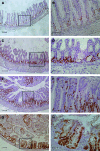Development of Cryptosporidium parvum-induced gastrointestinal neoplasia in severe combined immunodeficiency (SCID) mice: severity of lesions is correlated with infection intensity
- PMID: 20134002
- PMCID: PMC2813167
- DOI: 10.4269/ajtmh.2010.09-0309
Development of Cryptosporidium parvum-induced gastrointestinal neoplasia in severe combined immunodeficiency (SCID) mice: severity of lesions is correlated with infection intensity
Abstract
We reported previously that Cryptosporidium parvum was able to induce intestinal tumors in severe combined immunodeficiency (SCID) mice treated with corticoids. To further characterize this Cryptosporidium-induced cell transformation, SCID mice treated with dexamethasone were challenged with C. parvum oocysts, and euthanatized sequentially after infection for histologic examination. Ki-67 was used as a marker of cellular proliferation. Our previous results were confirmed, and it was also found that mice receiving higher inocula (10(6)-10(7)) experienced more severe neoplastic development. Additionally, neoplastic changes were observed not only in the caecum but also in the stomach and duodenum of some animals. Interestingly, SCID mice (6/6) inoculated with 10(5)-10(7) oocysts showed high grade intraepithelial neoplasia or adenomas with high grade dysplasia in the caecum after Day 46 post-infection (PI). Immunohistochemistry for Ki-67 staining indicated the neoplastic process associated to cryptosporidiosis, and evidenced the first immunohistochemical alterations at early stages of the process, even at 3 weeks PI.
Figures





Similar articles
-
Cryptosporidium parvum infection in SCID mice infected with only one oocyst: qPCR assessment of parasite replication in tissues and development of digestive cancer.PLoS One. 2012;7(12):e51232. doi: 10.1371/journal.pone.0051232. Epub 2012 Dec 13. PLoS One. 2012. PMID: 23272093 Free PMC article.
-
Cryptosporidiosis in adult and neonatal mice with severe combined immunodeficiency.J Comp Pathol. 1992 May;106(4):399-410. doi: 10.1016/0021-9975(92)90024-o. J Comp Pathol. 1992. PMID: 1644934
-
Fulminant cryptosporidiosis associated with digestive adenocarcinoma in SCID mice infected with Cryptosporidium parvum TUM1 strain.Int J Parasitol. 2010 Nov;40(13):1469-75. doi: 10.1016/j.ijpara.2010.07.007. Epub 2010 Aug 12. Int J Parasitol. 2010. PMID: 20708621
-
Human immunodeficiency virus infection and cryptosporidiosis: protective immune responses.Am J Trop Med Hyg. 1994;50(5 Suppl):29-35. Am J Trop Med Hyg. 1994. PMID: 8203720 Review.
-
Parasites and malignancies, a review, with emphasis on digestive cancer induced by Cryptosporidium parvum (Alveolata: Apicomplexa).Parasite. 2012 May;19(2):101-15. doi: 10.1051/parasite/2012192101. Epub 2012 Feb 1. Parasite. 2012. PMID: 22348213 Free PMC article. Review.
Cited by
-
Microbiome in human cancers.Access Microbiol. 2021 Aug 11;3(8):000247. doi: 10.1099/acmi.0.000247. eCollection 2021. Access Microbiol. 2021. PMID: 34888478 Free PMC article. Review.
-
Therapeutic Potency of Ginger, Garlic, and Pomegranate Extracts Against Cryptosporidium parvum-Mediated Gastro-Splenic Damage in Mice.Acta Parasitol. 2023 Mar;68(1):32-41. doi: 10.1007/s11686-022-00635-0. Epub 2022 Nov 8. Acta Parasitol. 2023. PMID: 36348178 Free PMC article.
-
Is Cryptosporidium a hijacker able to drive cancer cell proliferation?Food Waterborne Parasitol. 2022 Apr 14;27:e00153. doi: 10.1016/j.fawpar.2022.e00153. eCollection 2022 Jun. Food Waterborne Parasitol. 2022. PMID: 35498550 Free PMC article.
-
Prevalence and Genotyping of Cryptosporidium parvum in Gastrointestinal Cancer Patients.J Cancer. 2020 Mar 5;11(11):3334-3339. doi: 10.7150/jca.42393. eCollection 2020. J Cancer. 2020. PMID: 32231739 Free PMC article.
-
Deciphering Host-Pathogen Interactions: Role of Cryptosporidium in Tumorigenesis.Pathogens. 2025 Feb 20;14(3):208. doi: 10.3390/pathogens14030208. Pathogens. 2025. PMID: 40137692 Free PMC article. Review.
References
-
- Sunnotel O, Lowery CJ, Moore JE, Dooley JS, Xiao L, Millar BC, Rooney PJ, Snelling WJ. Cryptosporidium. Lett Appl Microbiol. 2006;43:7–16. - PubMed
-
- Pozio E, Morales MA. The impact of HIV-protease inhibitors on opportunistic parasites. Trends Parasitol. 2005;21:58–63. - PubMed
-
- Okhuysen PC, Chappell CL. Cryptosporidium virulence determinants–are we there yet? Int J Parasitol. 2002;32:517–525. - PubMed
-
- Izquierdo J, Antunez I, Calderon MT, Perez Giraldo C, Munoz Sanz A. Diarrhea caused by Cryptosporidium and colonic neoplasia. Rev Clin Esp. 1988;182:393–394. - PubMed
-
- Sulzyc-Bielicka V, Kuzna-Grygiel W, Kolodziejczyk L, Bielicki D, Kladny J, Stepien-Korzonek M, Telatynska-Smieszek B. Cryptosporidiosis in patients with colorectal cancer. J Parasitol. 2007;93:722–724. - PubMed
Publication types
MeSH terms
Substances
LinkOut - more resources
Full Text Sources
Medical
Molecular Biology Databases
Research Materials
Miscellaneous

